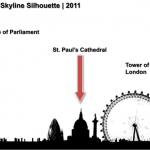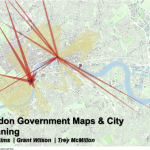As we prepare for the new semester, we asked two Brittain Fellows to reflect on their teaching experiences during the last semester.
Regina Martin
Teaching Modernism at Tech
Modernism lends itself really well to teaching multimodal communication at Tech because much of modernist art is heavily influenced by technological advancements at the turn of the 20th century. In teaching my class, “Modernism and Technology” this past semester (Spring 2011), my purpose was not so much to teach students about modernism but about how technology has cultural impacts beyond its immediate functions.
I introduced the topic by assigning chapters from Stephen Kern’s The Culture of Time and Space, 1880-1918, a scholarly text that looks at how technological advancements like wireless communication, film, and the automobile as well as scientific theories like Einstein’s Theory of Relativity and Heisenberg’s Uncertainty Principle created new ways of experiencing and time and space, which become apparent in modernist art and literature. Thus, students first considered the historical nature of space and time. Different cultures and different historical periods experience space and time differently. We further investigated this problem by reading Jane Austen’s Emma and Virginia Woolf’s Mrs. Dalloway simultaneously and considering how the dramatically different forms of those novels represent space and time differently and how that might be influenced by different technologies available during the two periods.
Because the purpose of the class was not to teach students modernism per se but to get them to think about the relationship between technology and cultural experience and production, I framed the focus on modernism as a springboard for thinking about how current technology has created new experiences of space and time and how that might be manifested in contemporary art and literature. For this reason, I gave students a choice for their final multimodal project, which consisted of an annotated bibliography, an oral presentation, and a visual argument: students could choose a modernist art movement and investigate its relationship to turn-of-the-twentieth-century technologies, or they could choose a recently developed technology—social networking, smartphones, MMORPGs, etc—and investigate its relationship to art and literature. In the end, by studying modernism through the lens of technology, students gained a broad historical perspective on the cultural impacts of technology.
Doris Bremm
“A New Way to Look at English Class”: Creating a Special Section for Architecture and Civil Engineering Majors
Having the option to create a special section for a particular major, it was an easy decision for me to design a course about “Mapping London: Britain’s Capital in Literature, Art, and Film” aimed at architecture and civil engineering majors for my ENGL 1102 this spring. It was my goal to incorporate my research interests such as twentieth-century British fiction, art and architecture, as well as theories of space and place, while at the same time creating a second-semester writing course that would be interesting and challenging for architecture majors and that would draw upon their special skills. Students in my special section soon started making connections between our class and their first year studio class in Architecture. I was pleased to find my students not only interested in the subject matter, but more importantly, aware of the goals of this special section. In reflection documents throughout the semester and in their final portfolio, students voiced their understanding of the importance of the skills they learned for their major and the applicability of those skills in their future work places.
Indeed, the class blog became a forum for students to discuss more than the literary representations of London the course focused on. Several posts reflected on the multi-modal assignments students worked on throughout the semester. One student in the special section for Architecture and Civil Engineering majors commented:
Although English at Georgia Tech has been different from my past English classes, I actually feel that they are more career-oriented. Instead of just reading a book or writing a paper, I am able to apply my talents and skills to a variety of subject areas. The concept of WOVEN… is an important idea to focus on since all of us will [have] to present our architectural designs to clients.
Links to selected blog posts:
https://mappinglondon2011.wordpress.com/2011/04/06/a-new-way-to-look-at-english-class/
https://mappinglondon2011.wordpress.com/2011/03/31/mapping-a-characters-development/
https://mappinglondon2011.wordpress.com/2011/04/18/character-analysis-via-map/
https://mappinglondon2011.wordpress.com/2011/04/17/the-development-of-group-and-map-procedure/
In designing the assignments for the semester, including elements from Georgia Tech’s W.O.V.E.N. spectrum was my most important goal, and thus maps of London, as a visual representation of the space we were about to enter, seemed the obvious place for us to get us started. Working in small groups, students first created a “digital poster” using Prezi or Power Point in which they analyzed a historical or contemporary map of London that they had chosen according to their interests. One group analyzed the “London View Management Framework” which depicts where in the city building height restrictions are strictly enforced to retain the sightlines of historically significant buildings from scenic areas of London
For the second assignment, I modified Dr. Roger Whitson’s map assignment to fit our class topic. Students used google maps to create an analysis of a character in Alan Moore and Eddie Campbell’s graphic novel From Hell or Virginia Woolf’s Mrs. Dalloway. Guido Moretti’s Maps, Graphs, Trees became an important tool for the to understand that
[maps] are a good way to prepare a text for analysis” (Maps, Graphs, Trees 53).
Once again, many of my architecture students excelled at incorporating their understanding of space in their analysis. Juxtaposing the daily routines of inhabitants of London’s east and west end in From Hell, or taking into account the importance of Elizabeth Dalloway’s bus ride to the City, they came to understand how place can be an important factor in characterization. My students were easily able to see the graphic representations of characters such as Queen Victoria as a way to represent emotions and create a particular atmosphere. (See link for an example: http://www.lmc.gatech.edu/~dbremm3/wordpress/wp-content/uploads/2011/04/MapVictoria.jpg)
In their final group projects, students were asked to take a less literal approach to mapping in their analyses of Zadie Smith’s novel White Teeth. They created posters, websites, podcasts, videos, etc. to present the multi-cultural world of the novel to an audience of their peers and professors at the library’s performance space. One group used Google SketchUp to include architectural renditions of typical living spaces in Bangladesh, Jamaica, and London to illustrate the characters’ world: http://wtcultureandhistory.weebly.com/influences-in-architecture.html
Creating this special section for Architecture and Civil Engineering Majors allowed me to pursue my own research interests in my teaching. I was continuously impressed with the ideas my students were able to incorporate into their assignments, and even more so, with their ability to reflect on the skills they honed in this class that they will draw upon throughout their college career and in their future jobs.


